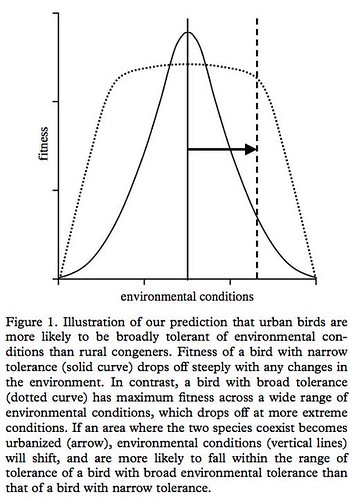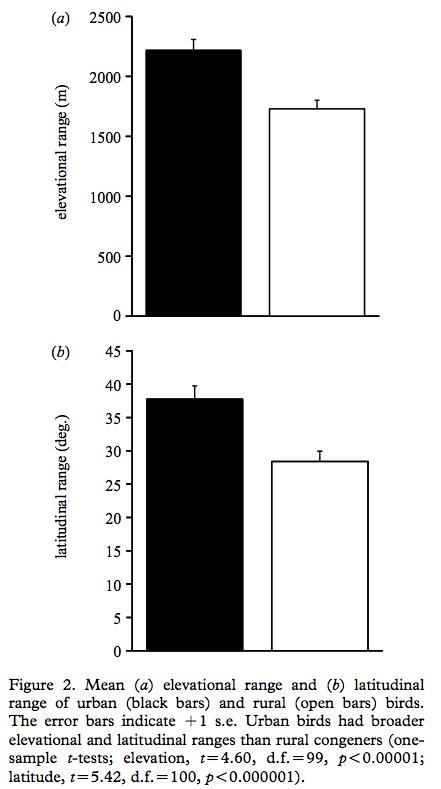tags: researchblogging.org, conservation, birds, ornithology, ecology, environment, endangered species
Image: Robert Linder.
I suppose this seems obvious to you city dwellers, but recently published research demonstrates that urban birds are better overall survivors than their country-dwelling cousins. Apparently, this is because city-dwelling birds are less specialized in their requirements, and thus, are more broadly adaptable to a variety of microenvironments, such as those found in large cities. While this might seem to be a mere conversational topic to many of you, this observation is important when trying to design conservation programs to preserve threatened and endangered species, particularly when these species' needs come into direct conflict with the ever-expanding human population.
"The urban habitat is usually more severe than the habitats these birds historically occupied," said study team member John Wingfield of the University of Washington, who was also my dissertation advisor. "Urban habitats aren't easy, so the birds have to have developed coping mechanisms."
The team, led by my grad school friend and colleague, Frances Bonier, who now is at Virginia Tech, predicted that environmental generalists would be tougher -- have a greater environmental tolerance -- than those species that have more specialized needs because the conditions of human-disturbed habitats are more likely to fall within those tolerated by generalist species (figure 1);
It is difficult to precisely define the relative "toughness" of any particular species, but for the purposes of this study, the team defined generalist species as those with a wide geographic distribution. Because a broad latitudinal and elevational distribution correlates strongly with a wide variety of ecological conditions tolerated by both animals and plants, this is a reasonable measure for a given species' environmental tolerance.
To identify which species of birds do best in city environments, the researchers sent questionnaires to ornithologists, biologists and birdwatchers all over the world asking them to list the 10 most common native breeding birds found in their cities.
To test this hypothesis, Bonier and her colleagues compared and analyzed 217 urban birds found in 73 of the world's largest cities and compared them to 247 rural native bird species from 14 taxonomic orders. To be included in the study, each rural species' breeding distribution had to geographically overlap with at least one of the study cities for which an urban species within the same genus ("congener") was reported as a common native breeder.
According to Bonier, some well known city-dwellers included starlings, parrots, crows, sparrows, pigeons and doves.
The team found that urban birds had significantly broader elevational and latitudinal distributions than did their rural congeners (figure 2). Surprisingly, this pattern remained unchanged even when the team's analyses were restricted to only one avian genus or one city within the United States.
This is the first phylogenetically controlled comparison between urban and rural avian species. It suggests that urban birds demonstrate a much wider variety of behavioral, physiological and ecological flexibility than demonstrated by rural birds, which makes urban birds more likely to survive and do well in a disturbed habitat, such as that occupied by large numbers of people. Further, other studies reveal that there are similar differences between individuals within the same species -- a factor that impacts birds that are kept and bred in captivity.
This study supports other studies and predictions, those birds that are specialists with small ranges are more likely to be at a greater risk for extinction than those species that have larger ranges and that exhibit a greater flexibility in their requirements.
"In the face of global climate change and human disturbances, such as increased urbanization and deforestation, we may be able to identify species that can cope with such changes," Wingfield observed. "Then we may be able to identify the species that cannot cope with these changes, or might even go extinct in the face of increased disruption."
"Our findings aren't surprising," Bonier pointed out in email. "[B]ut [they] are still exciting (at least to me), because our study was very broad and showed a really strong pattern, suggesting that this is something that matters a lot for determining which birds fare well with urbanization, and which don't."
Sources
Bonier, F., Martin, P.R., Wingfield, J.C. (2007). Urban birds have broader environmental tolerance. Biology Letters, 3(6), 670-673. DOI: 10.1098/rsbl.2007.0349 [PDF]
LiveScience (quotes).
- Log in to post comments




"Contrary to present predictions..." Just who was foolish enough to predict that animals with a broader geographic and environmental range would be more vulnerable to extinction than localized specialists?
well .. there's always the passenger pigeon example.
On the bus home this evening I was chatting to an urban(e) ecologist, who has been looking at urbanisation and carabids. He was saying that he thought there would be more carabids in suburban habitats.
Incidentally, increased specialisation is certainly related to declines in carabid populations - I did the analysis for a paper showing this a couple of years ago. Ah, this is what we wrote in our introduction:
Hmm, are urban birds tougher, or just less fussy?
Bob
IIRC, the passenger pigeons didn't succumb to environmental stress, rather they were sport-hunted to extinction, largely with shotguns and matching attitudes. Definitely not one of Homo sapiens' prouder accomplishments, but impressive in a sociopathic sort of way.
I spoke to The Master Baiter about this. He said part of the reason pigeons stay healthier is they spend a lot of time avoiding people trying to spit on them. Of course he was drinking heavily, and smoking at the time, so I don't know how much weight you can put on that theory.
Cheers!
Hi Devorah!
Thanks for writing the nice piece about our paper. Just one point of clarification - the "contrary to present predictions" statement is not in our paper. We felt that our findings really supported present predictions and ideas. Our findings aren't surprising, but are still exciting (at least to me) because our study was very broad and showed a really strong pattern, suggesting that this is something that matters a lot for determining which birds fare well with urbanization, and which don't. Also - I saw a few really nice urban-rural gradient papers on carabid beetles, and do cite one in the paper, too.
thanks again,
Fran